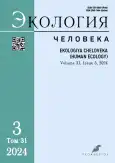Анализ террористической активности в мире в 1970–2020 гг.
- Авторы: Евдокимов В.И.1, Чернов К.А.2, Шуленин Н.С.3
-
Учреждения:
- Всероссийский центр экстренной и радиационной медицины им. А.М. Никифорова
- Академия гражданской защиты МЧС России
- Санкт-Петербургский медико-социальный институт
- Выпуск: Том 31, № 3 (2024)
- Страницы: 191-199
- Раздел: ОРИГИНАЛЬНЫЕ ИССЛЕДОВАНИЯ
- URL: https://journal-vniispk.ru/1728-0869/article/view/316091
- DOI: https://doi.org/10.17816/humeco629531
- ID: 316091
Цитировать
Полный текст
Аннотация
Обоснование. В последние годы число вооружённых конфликтов, террористических актов (ТА) и их медико-биологических последствий увеличивается.
Цель. Проанализировать показатели террористической активности в мире с 1970 по 2020 г. для оптимизации проведения контртеррористических мероприятий.
Материал и методы. Объектом исследования стали показатели Глобальной базы данных по терроризму (Global Terrorism Database, GTD). Индивидуальные риски гибели и получения травмы в ТА рассчитали на 1 млн населения. Представлены средние величины, медианы, верхние и нижние квартили (Me [Q25; Q75]).
Результаты. За 51 год (1970–2020 гг.) в мире учтены около 215 тыс. ТА, в которых погибли 498,5 тыс. человек, получили травмы 597,8 тыс. Среднегодовой показатель террористической активности — 4,2 тыс. ТА (3,1 [1,4; 4,8] тыс. ТА), гибели — 9,6 тыс. человек (7,1 [4,4; 10,3] тыс. человек), получения травмы — 11,7 тыс. человек (7,6 [3,6; 15,9] тыс. человек). Проанализировали ТА по регионам мира, типу, использованному оружию и объектам (целям). Индивидуальный риск гибели для населения мира без учёта террористов оказался 1,25×10–6 (1,16 [0,64; 1,73]×10–6) смертей/(человек×год), получить травму — 1,71×10–6 (1,32 [0,80; 2,28]×10–6) травм/(человек×год). Отмечается динамика увеличения рисков.
Заключение. Чаще всего в ТА использовались взрывчатые вещества и огнестрельное оружие, поэтому предотвратить гибель и травмирование людей было очень затруднительно. Около половины ТА не имеет медико-биологических последствий, но вероятность погибнуть при терроризме не уменьшается. Если терроризм полностью искоренить невозможно, то контртеррористическими мероприятиями его можно минимизировать.
Ключевые слова
Полный текст
Открыть статью на сайте журналаОб авторах
Владимир Иванович Евдокимов
Всероссийский центр экстренной и радиационной медицины им. А.М. Никифорова
Автор, ответственный за переписку.
Email: 9334616@mail.ru
ORCID iD: 0000-0002-0771-2102
SPIN-код: 1692-4593
д-р мед. наук, профессор
Россия, Санкт-ПетербургКирилл Александрович Чернов
Академия гражданской защиты МЧС России
Email: kchernovmd@gmail.com
ORCID iD: 0000-0002-7625-4432
SPIN-код: 9224-7846
канд. мед. наук
Россия, ХимкиНиколай Сергеевич Шуленин
Санкт-Петербургский медико-социальный институт
Email: shulenin.ns@gmail.com
ORCID iD: 0009-0008-4567-9279
SPIN-код: 3497-2982
канд. мед. наук, доцент
Россия, Санкт-ПетербургСписок литературы
- Acosta B., Ramos K. Introducing the 1993 terrorism and political violence dataset // Studies in Conflict and Terrorism. 2016. Vol. 40, N 3. P. 1–34. doi: 10.1080/1057610X.2016.1184061
- GTD Global Terrorism Database. Codebook: methodology, inclusion criteria, and variables. College Park: START, 2021.
- Miller E., Wingenroth B. Global Terrorism Database: real-time data collection pilot evaluation. College Park: START, 2023.
- Рязанов Д.С., Охрименко А.В. Использование электронных баз данных в исследовании терроризма // Исторические, философские, политические и юридические науки, культурология и искусствоведение. Вопросы теории и практики. 2015. № 11-2. С. 172–176. EDN: UMESVJ
- Besenyő J., Barten D.G., De Cauwer H.G., et al. Review of ambulance terrorism on the African continent // Prehosp Disaster Med. 2023. Vol. 38, N 2. P. 237–242. doi: 10.1017/S1049023X23000213
- Cavaliere G.A., Alfalasi R., Jasani G.N., et al. Terrorist attacks against healthcare facilities: a review // Health Secur. 2021. Vol. 19, N 5. P. 546–550. doi: 10.1089/ hs.2021.0004
- Hoth P., Roth J., Bieler D., et al. Education and training as a key enabler of successful patient care in mass-casualty terrorist incidents // Eur J Trauma Emerg Surg. 2023. Vol. 49, N 2. P. 595–605. doi: 10.1007/s00068-023-02232-w
- Wirken B., Barten D.G., De Cauwer H., et al. Primary care as primary target: a review of terrorist attacks against primary care providers and their offices // Prehosp Disaster Med. 2022. Vol. 37, N 4. P. 451–454. doi: 10.1017/S1049023X22000954
- Гржибовский А.М., Унгуряну Т.Н. Анализ биомедицинских данных с использованием пакета статистических программ SPSS: учеб. пособие. Архангельск: Изд-во СГМУ, 2017. EDN: YQUSOF
- Холматова К.К., Гржибовский А.М. Панельные исследования и исследования тренда в медицине и общественном здравоохранении // Экология человека. 2016. № 10. С. 57–63. EDN: WQSIDR doi: 10.33396/1728-0869-2016-9-57-64
Дополнительные файлы











